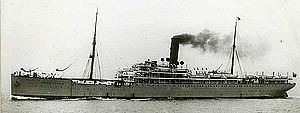HMHS Dover Castle

The Dover Castle before her wartime service
|
|
| History | |
|---|---|
| Name: | Dover Castle |
| Owner: | Union-Castle Mail Steamship Company |
| Builder: | Barclay Curle & Company, Glasgow |
| Yard number: | 443 |
| Launched: | 4 February 1904 |
| Fate: | Torpedoed by German U-boat UC-67 |
| General characteristics | |
| Tonnage: | 8,271 tonnes |
| Length: | 476.4 ft (145.2 m) |
| Beam: | 56.7 ft (17.3 m) |
| Draught: | 31.9 ft (9.7 m) |
| Propulsion: | Steam, quadruple expansion engines, 969 nhp |
| Speed: | 14.5 knots (26.9 km/h) |
HMHS Dover Castle (His Majesty's Hospital Ship) was a steam ship originally built for the Union-Castle Line, but requisitioned for use as a British hospital ship during the First World War. On 26 May 1917 she was torpedoed by German U-boat UC-67
SS Dover Castle was built by Barclay Curle & Company, Glasgow as yard number 443, in 1904 and launched on 4 February 1904. She was powered by quadruple expansion stream engines. She was built as a combined passenger and cargo vessel for the Union-Castle Mail Steamship Company, of London.
On 4 October 1916, Franconia, while heading for Salonika, was torpedoed and sunk by the German U-boat UB-47 195 nautical miles (361 km) east of Malta. She was not carrying any troops but out of her 314 crew members, 12 died. The others (302) were saved by the Dover Castle.
Dover Castle was torpedoed by the German U-boat UC-67 on 26 May 1917, while 50 miles (80 km) north of Bône on passage from Malta to Gibraltar. The initial explosion killed seven boiler stokers, but the crew was able to evacuate the wounded onto HMS Cameleon. The captain and a small crew tried to save the ship, but she was hit by a second torpedo an hour later and sank in three minutes at 37°45′N 7°45′E / 37.750°N 7.750°ECoordinates: 37°45′N 7°45′E / 37.750°N 7.750°E.
...
Wikipedia
